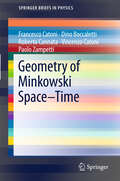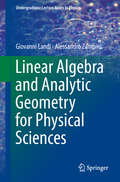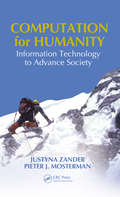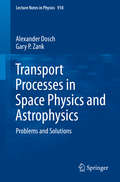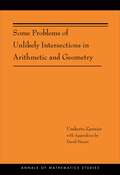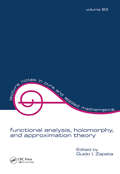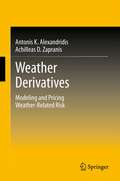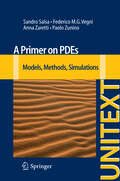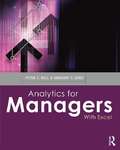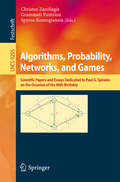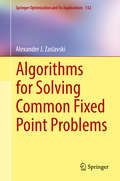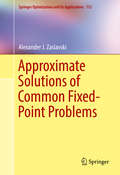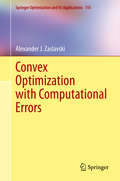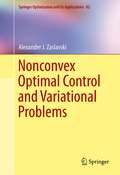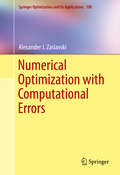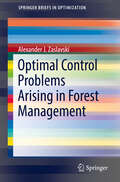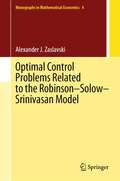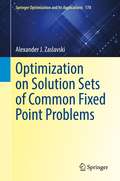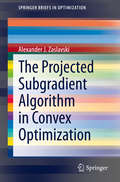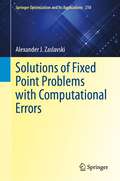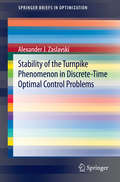- Table View
- List View
Geometric Invariant Theory, Holomorphic Vector Bundles and the Harder-Narasimhan Filtration (SpringerBriefs in Mathematics)
by Alfonso Zamora Saiz Ronald A. Zúñiga-RojasThis book introduces key topics on Geometric Invariant Theory, a technique to obtaining quotients in algebraic geometry with a good set of properties, through various examples. It starts from the classical Hilbert classification of binary forms, advancing to the construction of the moduli space of semistable holomorphic vector bundles, and to Hitchin’s theory on Higgs bundles. The relationship between the notion of stability between algebraic, differential and symplectic geometry settings is also covered.Unstable objects in moduli problems -- a result of the construction of moduli spaces -- get specific attention in this work. The notion of the Harder-Narasimhan filtration as a tool to handle them, and its relationship with GIT quotients, provide instigating new calculations in several problems. Applications include a survey of research results on correspondences between Harder-Narasimhan filtrations with the GIT picture and stratifications of the moduli space of Higgs bundles.Graduate students and researchers who want to approach Geometric Invariant Theory in moduli constructions can greatly benefit from this reading, whose key prerequisites are general courses on algebraic geometry and differential geometry.
Geometry of Minkowski Space-Time
by Paolo Zampetti Vincenzo Catoni Roberto Cannata Francesco Catoni Dino BoccalettiThis book provides an original introduction to the geometry of Minkowski space-time. A hundred years after the space-time formulation of special relativity by Hermann Minkowski, it is shown that the kinematical consequences of special relativity are merely a manifestation of space-time geometry. The book is written with the intention of providing students (and teachers) of the first years of University courses with a tool which is easy to be applied and allows the solution of any problem of relativistic kinematics at the same time. The book treats in a rigorous way, but using a non-sophisticated mathematics, the Kinematics of Special Relativity. As an example, the famous "Twin Paradox" is completely solved for all kinds of motions. The novelty of the presentation in this book consists in the extensive use of hyperbolic numbers, the simplest extension of complex numbers, for a complete formalization of the kinematics in the Minkowski space-time. Moreover, from this formalization the understanding of gravity comes as a manifestation of curvature of space-time, suggesting new research fields.
Linear Algebra and Analytic Geometry for Physical Sciences (Undergraduate Lecture Notes in Physics)
by Alessandro Zampini Giovanni LandiA self-contained introduction to finite dimensional vector spaces, matrices, systems of linear equations, spectral analysis on euclidean and hermitian spaces, affine euclidean geometry, quadratic forms and conic sections. The mathematical formalism is motivated and introduced by problems from physics, notably mechanics (including celestial) and electro-magnetism, with more than two hundreds examples and solved exercises.Topics include: The group of orthogonal transformations on euclidean spaces, in particular rotations, with Euler angles and angular velocity. The rigid body with its inertia matrix. The unitary group. Lie algebras and exponential map. The Dirac’s bra-ket formalism. Spectral theory for self-adjoint endomorphisms on euclidean and hermitian spaces. The Minkowski spacetime from special relativity and the Maxwell equations. Conic sections with the use of eccentricity and Keplerian motions. An appendix collects basic algebraic notions like group, ring and field; and complex numbers and integers modulo a prime number.The book will be useful to students taking a physics or engineer degree for a basic education as well as for students who wish to be competent in the subject and who may want to pursue a post-graduate qualification.
Computation for Humanity: Information Technology to Advance Society (Computational Analysis, Synthesis, and Design of Dynamic Systems)
by Justyna Zander Pieter J. MostermanThe exponential progress and accessibility of computing has vastly increased data flows and revolutionized the practice of science, engineering, and communication. Computing plays a critical role in advancing research across almost every scientific discipline. Computation for Humanity: Information Technology to Advance Society is a guide for the creation of services, products, and tools that facilitate, support, and enhance progress of humanity toward more sustainable life. This book: Provides a deep understanding of the practical applications of computation to solve human-machine problems Delivers insight into theoretical approaches in an accessible manner Provides a comprehensive overview of computational science and engineering applications in selected disciplines Crosses the boundaries between different domains and shows how they interrelate and complement one another Focuses on grand challenges and issues that matter for the future of humanity Shows different perspectives of computational thinking, understanding, and reasoning Provides a basis for scientific discoveries and enables adopting scientific theories and engineering practices from other disciplines Takes a step back to provide a human-related abstraction level that is not ultimately seen in pure technological elaborations/collections The editors provide a collection of numerous computation-related projects that form a foundation from which to cross-pollinate between different disciplines and further extensive collaboration. They present a clear and profound understanding of computing in today's world, and provide fundamental solutions to some of the most pertinent humanity-related problems.
Transport Processes in Space Physics and Astrophysics
by Gary P. Zank Alexander DoschThis is the problems and solution manual for the graduate text with the same title and published as Lecture Notes in Physics Vol 877 which provides the necessary mathematical and physics background to understand the transport of gases, charged particle gases, energetic charged particles, turbulence, and radiation in an astrophysical and space physics context. The very detailed and self-contained problems and solutions will be an essential part of the training of any graduate student wishing to enter and pursuing research in this field.
Some Problems of Unlikely Intersections in Arithmetic and Geometry (Annals of Mathematics Studies #181)
by Umberto ZannierThis book considers the so-called Unlikely Intersections, a topic that embraces well-known issues, such as Lang's and Manin-Mumford's, concerning torsion points in subvarieties of tori or abelian varieties. More generally, the book considers algebraic subgroups that meet a given subvariety in a set of unlikely dimension. The book is an expansion of the Hermann Weyl Lectures delivered by Umberto Zannier at the Institute for Advanced Study in Princeton in May 2010. The book consists of four chapters and seven brief appendixes, the last six by David Masser. The first chapter considers multiplicative algebraic groups, presenting proofs of several developments, ranging from the origins to recent results, and discussing many applications and relations with other contexts. The second chapter considers an analogue in arithmetic and several applications of this. The third chapter introduces a new method for approaching some of these questions, and presents a detailed application of this (by Masser and the author) to a relative case of the Manin-Mumford issue. The fourth chapter focuses on the André-Oort conjecture (outlining work by Pila).
Playing with Infinity: Turtles, Patterns, and Pictures (AK Peters/CRC Recreational Mathematics Series)
by Hans ZantemaThis is a book about infinity - specifically the infinity of numbers and sequences. Amazing properties arise, for instance, some kinds of infinity are argued to be greater than others. Along the way the author will demonstrate how infinity can be made to create beautiful ‘art’, guided by the development of underlying mathematics. This book will provide a fascinating read for anyone interested in number theory, infinity, math art, and/or generative art, and could be used a valuable supplement to any course on these topics.Features: Beautiful examples of generative art Accessible to anyone with a reasonable high school level of mathematics Full of challenges and puzzles to engage readers
Functional Analysis, Holomorphy, and Approximation Theory (Lecture Notes In Pure And Applied Mathematics Ser. #83)
by Guido I. ZapataThis book contains papers on complex analysis, function spaces, harmonic analysis, and operators, presented at the International seminar on Functional Analysis, Holomorphy, and Approximation Theory held in 1979. It is addressed to mathematicians and advanced graduate students in mathematics.
Weather Derivatives
by Achilleas D. Zapranis Antonis Alexandridis K.Weather derivatives are financial instruments that can be used by organizations or individuals as part of a risk management strategy to minimize risk associated with adverse or unexpected weather conditions. Just as traditional contingent claims, a weather derivative has an underlying measure, such as: rainfall, wind, snow or temperature. Nearly $1 trillion of the U.S. economy is directly exposed to weather-related risk. More precisely, almost 30% of the U.S. economy and 70% of U.S. companies are affected by weather. The purpose of this monograph is to conduct an in-depth analysis of financial products that are traded in the weather market. Presenting a pricing and modeling approach for weather derivatives written on various underlying weather variables will help students, researchers, and industry professionals accurately price weather derivatives, and will provide strategies for effectively hedging against weather-related risk. This book will link the mathematical aspects of the modeling procedure of weather variables to the financial markets and the pricing of weather derivatives. Very little has been published in the area of weather risk, and this volume will appeal to graduate-level students and researchers studying financial mathematics, risk management, or energy finance, in addition to investors and professionals within the financial services industry.
A Primer on PDEs: Models, Methods, Simulations (UNITEXT)
by Anna Zaretti Federico Vegni Paolo Zunino Sandro SalsaThis book is designed as an advanced undergraduate or a first-year graduate course for students from various disciplines like applied mathematics, physics, engineering. It has evolved while teaching courses on partial differential equations during the last decade at the Politecnico of Milan. The main purpose of these courses was twofold: on the one hand, to train the students to appreciate the interplay between theory and modelling in problems arising in the applied sciences and on the other hand to give them a solid background for numerical methods, such as finite differences and finite elements.
Analytics for Managers: With Excel
by Gregory S. Zaric Peter C. BellAnalytics is one of a number of terms which are used to describe a data-driven more scientific approach to management. Ability in analytics is an essential management skill: knowledge of data and analytics helps the manager to analyze decision situations, prevent problem situations from arising, identify new opportunities, and often enables many millions of dollars to be added to the bottom line for the organization. The objective of this book is to introduce analytics from the perspective of the general manager of a corporation. Rather than examine the details or attempt an encyclopaedic review of the field, this text emphasizes the strategic role that analytics is playing in globally competitive corporations today. The chapters of this book are organized in two main parts. The first part introduces a problem area and presents some basic analytical concepts that have been successfully used to address the problem area. The objective of this material is to provide the student, the manager of the future, with a general understanding of the tools and techniques used by the analyst.
Nonlinear Dynamics: Exploration Through Normal Forms (Dover Books On Physics Series #Vol. 5)
by Prof. Yair Zarmi Peter B. KahnGeared toward advanced undergraduates and graduate students, this exposition covers the method of normal forms and its application to ordinary differential equations through perturbation analysis. In addition to its emphasis on the freedom inherent in the normal form expansion, the text features numerous examples of equations, the kind of which are encountered in many areas of science and engineering. The treatment begins with an introduction to the basic concepts underlying the normal forms. Coverage then shifts to an investigation of systems with one degree of freedom that model oscillations, in which the force has a dominant linear term and a small nonlinear one. The text considers a variety of nonautonomous systems that arise during the study of forced oscillatory motion. Topics include boundary value problems, connections to the method of the center manifold, linear and nonlinear Mathieu equations, pendula, Nuclear Magnetic Resonance, coupled oscillator systems, and other subjects. 1998 edition.
Algorithms, Probability, Networks, and Games: Scientific Papers and Essays Dedicated to Paul G. Spirakis on the Occasion of His 60th Birthday (Lecture Notes in Computer Science #9295)
by Christos Zaroliagis Grammati Pantziou Spyros KontogiannisThis Festschrift volume is published in honor of Professor Paul G. Spirakis on the occasion of his 60th birthday. It celebrates his significant contributions to computer science as an eminent, talented, and influential researcher and most visionary thought leader, with a great talent in inspiring and guiding young researchers. The book is a reflection of his main research activities in the fields of algorithms, probability, networks, and games, and contains a biographical sketch as well as essays and research contributions from close collaborators and former PhD students.
Algorithms for Solving Common Fixed Point Problems (Springer Optimization And Its Applications #132)
by Alexander J. ZaslavskiThis book details approximate solutions to common fixed point problems and convex feasibility problems in the presence of perturbations. Convex feasibility problems search for a common point of a finite collection of subsets in a Hilbert space; common fixed point problems pursue a common fixed point of a finite collection of self-mappings in a Hilbert space. A variety of algorithms are considered in this book for solving both types of problems, the study of which has fueled a rapidly growing area of research. This monograph is timely and highlights the numerous applications to engineering, computed tomography, and radiation therapy planning.<P><P> Totaling eight chapters, this book begins with an introduction to foundational material and moves on to examine iterative methods in metric spaces. The dynamic string-averaging methods for common fixed point problems in normed space are analyzed in Chapter 3. Dynamic string methods, for common fixed point problems in a metric space are introduced and discussed in Chapter 4. Chapter 5 is devoted to the convergence of an abstract version of the algorithm which has been called component-averaged row projections (CARP). Chapter 6 studies a proximal algorithm for finding a common zero of a family of maximal monotone operators. Chapter 7 extends the results of Chapter 6 for a dynamic string-averaging version of the proximal algorithm. In Chapters 8 subgradient projections algorithms for convex feasibility problems are examined for infinite dimensional Hilbert spaces.
Approximate Solutions of Common Fixed-Point Problems (Springer Optimization and Its Applications #112)
by Alexander J. ZaslavskiThis book presents results on theconvergence behavior of algorithms which are known as vital tools for solvingconvex feasibility problems and common fixed point problems. The main goal forus in dealing with a known computational error is to find what approximatesolution can be obtained and how many iterates one needs to find it. Accordingto know results, these algorithms should converge to a solution. In thisexposition, these algorithms are studied, taking into account computationalerrors which remain consistent in practice. In this case the convergence to asolution does not take place. We show that our algorithms generate a goodapproximate solution if computational errors are bounded from above by a smallpositive constant. Beginning with an introduction, this monograph moves onto study: · dynamicstring-averaging methods for common fixed point problems in a Hilbert space · dynamicstring methods for common fixed point problems in a metric space · dynamicstring-averaging version of the proximal algorithm · common fixedpoint problems in metric spaces · common fixedpoint problems in the spaces with distances of the Bregman type · a proximalalgorithm for finding a common zero of a family of maximal monotone operators · subgradientprojections algorithms for convex feasibility problems in Hilbert spaces
Convex Optimization with Computational Errors (Springer Optimization and Its Applications #155)
by Alexander J. ZaslavskiThe book is devoted to the study of approximate solutions of optimization problems in the presence of computational errors. It contains a number of results on the convergence behavior of algorithms in a Hilbert space, which are known as important tools for solving optimization problems. The research presented in the book is the continuation and the further development of the author's (c) 2016 book Numerical Optimization with Computational Errors, Springer 2016. Both books study the algorithms taking into account computational errors which are always present in practice. The main goal is, for a known computational error, to find out what an approximate solution can be obtained and how many iterates one needs for this. The main difference between this new book and the 2016 book is that in this present book the discussion takes into consideration the fact that for every algorithm, its iteration consists of several steps and that computational errors for different steps are generally, different. This fact, which was not taken into account in the previous book, is indeed important in practice. For example, the subgradient projection algorithm consists of two steps. The first step is a calculation of a subgradient of the objective function while in the second one we calculate a projection on the feasible set. In each of these two steps there is a computational error and these two computational errors are different in general. It may happen that the feasible set is simple and the objective function is complicated. As a result, the computational error, made when one calculates the projection, is essentially smaller than the computational error of the calculation of the subgradient. Clearly, an opposite case is possible too. Another feature of this book is a study of a number of important algorithms which appeared recently in the literature and which are not discussed in the previous book. This monograph contains 12 chapters. Chapter 1 is an introduction. In Chapter 2 we study the subgradient projection algorithm for minimization of convex and nonsmooth functions. We generalize the results of [NOCE] and establish results which has no prototype in [NOCE]. In Chapter 3 we analyze the mirror descent algorithm for minimization of convex and nonsmooth functions, under the presence of computational errors. For this algorithm each iteration consists of two steps. The first step is a calculation of a subgradient of the objective function while in the second one we solve an auxiliary minimization problem on the set of feasible points. In each of these two steps there is a computational error. We generalize the results of [NOCE] and establish results which has no prototype in [NOCE]. In Chapter 4 we analyze the projected gradient algorithm with a smooth objective function under the presence of computational errors. In Chapter 5 we consider an algorithm, which is an extension of the projection gradient algorithm used for solving linear inverse problems arising in signal/image processing. In Chapter 6 we study continuous subgradient method and continuous subgradient projection algorithm for minimization of convex nonsmooth functions and for computing the saddle points of convex-concave functions, under the presence of computational errors. All the results of this chapter has no prototype in [NOCE]. In Chapters 7-12 we analyze several algorithms under the presence of computational errors which were not considered in [NOCE]. Again, each step of an iteration has a computational errors and we take into account that these errors are, in general, different. An optimization problems with a composite objective function is studied in Chapter 7. A zero-sum game with two-players is considered in Chapter 8. A predicted decrease approximation-based method is used in Chapter 9 for constrained convex optimization. Chapter 10 is devoted to minimization of quasiconvex functions. Minimization of sharp weakly convex functions is discussed
Nonconvex Optimal Control and Variational Problems
by Alexander J. ZaslavskiNonconvex Optimal Control and Variational Problems is an important contribution to the existing literature in the field and is devoted to the presentation of progress made in the last 15 years of research in the area of optimal control and the calculus of variations. This volume contains a number of results concerning well-posedness of optimal control and variational problems, nonoccurrence of the Lavrentiev phenomenon for optimal control and variational problems, and turnpike properties of approximate solutions of variational problems. Chapter 1 contains an introduction as well as examples of select topics. Chapters 2-5 consider the well-posedness condition using fine tools of general topology and porosity. Chapters 6-8 are devoted to the nonoccurrence of the Lavrentiev phenomenon and contain original results. Chapter 9 focuses on infinite-dimensional linear control problems, and Chapter 10 deals with "good" functions and explores new understandings on the questions of optimality and variational problems. Finally, Chapters 11-12 are centered around the turnpike property, a particular area of expertise for the author. This volume is intended for mathematicians, engineers, and scientists interested in the calculus of variations, optimal control, optimization, and applied functional analysis, as well as both undergraduate and graduate students specializing in those areas. The text devoted to Turnpike properties may be of particular interest to the economics community.
Numerical Optimization with Computational Errors
by Alexander J. ZaslavskiThis book studies the approximate solutions of optimization problems in the presence of computational errors. A number of results are presented on the convergence behavior of algorithms in a Hilbert space; these algorithms are examined taking into account computational errors. The author illustrates that algorithms generate a good approximate solution, if computational errors are bounded from above by a small positive constant. Known computational errors are examined with the aim of determining an approximate solution. Researchers and students interested in the optimization theory and its applications will find this book instructive and informative. This monograph contains 16 chapters; including a chapters devoted to the subgradient projection algorithm, the mirror descent algorithm, gradient projection algorithm, the Weiszfelds method, constrained convex minimization problems, the convergence of a proximal point method in a Hilbert space, the continuous subgradient method, penalty methods and Newton s method. "
Optimal Control Problems Arising in Forest Management (SpringerBriefs in Optimization)
by Alexander J. ZaslavskiThis book is devoted to the study of optimal control problems arising in forest management, an important and fascinating topic in mathematical economics studied by many researchers over the years. The volume studies the forest management problem by analyzing a class of optimal control problems that contains it and showing the existence of optimal solutions over infinite horizon. It also studies the structure of approximate solutions on finite intervals and their turnpike properties, as well as the stability of the turnpike phenomenon and the structure of approximate solutions on finite intervals in the regions close to the end points. The book is intended for mathematicians interested in the optimization theory, optimal control and their applications to the economic theory.
Optimal Control Problems Related to the Robinson–Solow–Srinivasan Model (Monographs in Mathematical Economics #4)
by Alexander J. ZaslavskiThis book is devoted to the study of classes of optimal control problems arising in economic growth theory, related to the Robinson–Solow–Srinivasan (RSS) model. The model was introduced in the 1960s by economists Joan Robinson, Robert Solow, and Thirukodikaval Nilakanta Srinivasan and was further studied by Robinson, Nobuo Okishio, and Joseph Stiglitz. Since then, the study of the RSS model has become an important element of economic dynamics. In this book, two large general classes of optimal control problems, both of them containing the RSS model as a particular case, are presented for study. For these two classes, a turnpike theory is developed and the existence of solutions to the corresponding infinite horizon optimal control problems is established. The book contains 9 chapters. Chapter 1 discusses turnpike properties for some optimal control problems that are known in the literature, including problems corresponding to the RSS model. The first class of optimal control problems is studied in Chaps. 2–6. In Chap. 2, infinite horizon optimal control problems with nonautonomous optimality criteria are considered. The utility functions, which determine the optimality criterion, are nonconcave. This class of models contains the RSS model as a particular case. The stability of the turnpike phenomenon of the one-dimensional nonautonomous concave RSS model is analyzed in Chap. 3. The following chapter takes up the study of a class of autonomous nonconcave optimal control problems, a subclass of problems considered in Chap. 2. The equivalence of the turnpike property and the asymptotic turnpike property, as well as the stability of the turnpike phenomenon, is established. Turnpike conditions and the stability of the turnpike phenomenon for nonautonomous problems are examined in Chap. 5, with Chap. 6 devoted to the study of the turnpike properties for the one-dimensional nonautonomous nonconcave RSS model. The utility functions, which determine the optimality criterion, are nonconcave. The class of RSS models is identified with a complete metric space of utility functions. Using the Baire category approach, the turnpike phenomenon is shown to hold for most of the models. Chapter 7 begins the study of the second large class of autonomous optimal control problems, and turnpike conditions are established. The stability of the turnpike phenomenon for this class of problems is investigated further in Chaps. 8 and 9.
Optimization in Banach Spaces (SpringerBriefs in Optimization)
by Alexander J. ZaslavskiThe book is devoted to the study of constrained minimization problems on closed and convex sets in Banach spaces with a Frechet differentiable objective function. Such problems are well studied in a finite-dimensional space and in an infinite-dimensional Hilbert space. When the space is Hilbert there are many algorithms for solving optimization problems including the gradient projection algorithm which is one of the most important tools in the optimization theory, nonlinear analysis and their applications. An optimization problem is described by an objective function and a set of feasible points. For the gradient projection algorithm each iteration consists of two steps. The first step is a calculation of a gradient of the objective function while in the second one we calculate a projection on the feasible set. In each of these two steps there is a computational error. In our recent research we show that the gradient projection algorithm generates a good approximate solution, if all the computational errors are bounded from above by a small positive constant. It should be mentioned that the properties of a Hilbert space play an important role. When we consider an optimization problem in a general Banach space the situation becomes more difficult and less understood. On the other hand such problems arise in the approximation theory. The book is of interest for mathematicians working in optimization. It also can be useful in preparation courses for graduate students. The main feature of the book which appeals specifically to this audience is the study of algorithms for convex and nonconvex minimization problems in a general Banach space. The book is of interest for experts in applications of optimization to the approximation theory.In this book the goal is to obtain a good approximate solution of the constrained optimization problem in a general Banach space under the presence of computational errors. It is shown that the algorithm generates a good approximate solution, if the sequence of computational errors is bounded from above by a small constant. The book consists of four chapters. In the first we discuss several algorithms which are studied in the book and prove a convergence result for an unconstrained problem which is a prototype of our results for the constrained problem. In Chapter 2 we analyze convex optimization problems. Nonconvex optimization problems are studied in Chapter 3. In Chapter 4 we study continuous algorithms for minimization problems under the presence of computational errors. The algorithm generates a good approximate solution, if the sequence of computational errors is bounded from above by a small constant. The book consists of four chapters. In the first we discuss several algorithms which are studied in the book and prove a convergence result for an unconstrained problem which is a prototype of our results for the constrained problem. In Chapter 2 we analyze convex optimization problems. Nonconvex optimization problems are studied in Chapter 3. In Chapter 4 we study continuous algorithms for minimization problems under the presence of computational errors.
Optimization on Solution Sets of Common Fixed Point Problems (Springer Optimization and Its Applications #178)
by Alexander J. ZaslavskiThis book is devoted to a detailed study of the subgradient projection method and its variants for convex optimization problems over the solution sets of common fixed point problems and convex feasibility problems. These optimization problems are investigated to determine good solutions obtained by different versions of the subgradient projection algorithm in the presence of sufficiently small computational errors. The use of selected algorithms is highlighted including the Cimmino type subgradient, the iterative subgradient, and the dynamic string-averaging subgradient. All results presented are new. Optimization problems where the underlying constraints are the solution sets of other problems, frequently occur in applied mathematics. The reader should not miss the section in Chapter 1 which considers some examples arising in the real world applications. The problems discussed have an important impact in optimization theory as well. The book will be useful for researches interested in the optimization theory and its applications.
The Projected Subgradient Algorithm in Convex Optimization (SpringerBriefs in Optimization)
by Alexander J. ZaslavskiThis focused monograph presents a study of subgradient algorithms for constrained minimization problems in a Hilbert space. The book is of interest for experts in applications of optimization to engineering and economics. The goal is to obtain a good approximate solution of the problem in the presence of computational errors. The discussion takes into consideration the fact that for every algorithm its iteration consists of several steps and that computational errors for different steps are different, in general. The book is especially useful for the reader because it contains solutions to a number of difficult and interesting problems in the numerical optimization. The subgradient projection algorithm is one of the most important tools in optimization theory and its applications. An optimization problem is described by an objective function and a set of feasible points. For this algorithm each iteration consists of two steps. The first step requires a calculation of a subgradient of the objective function; the second requires a calculation of a projection on the feasible set. The computational errors in each of these two steps are different. This book shows that the algorithm discussed, generates a good approximate solution, if all the computational errors are bounded from above by a small positive constant. Moreover, if computational errors for the two steps of the algorithm are known, one discovers an approximate solution and how many iterations one needs for this. In addition to their mathematical interest, the generalizations considered in this book have a significant practical meaning.
Solutions of Fixed Point Problems with Computational Errors (Springer Optimization and Its Applications #210)
by Alexander J. ZaslavskiThe book is devoted to the study of approximate solutions of fixed point problems in the presence of computational errors. It begins with a study of approximate solutions of star-shaped feasibility problems in the presence of perturbations. The goal is to show the convergence of algorithms, which are known as important tools for solving convex feasibility problems and common fixed point problems.The text also presents studies of algorithms based on unions of nonexpansive maps, inconsistent convex feasibility problems, and split common fixed point problems. A number of algorithms are considered for solving convex feasibility problems and common fixed point problems. The book will be of interest for researchers and engineers working in optimization, numerical analysis, and fixed point theory. It also can be useful in preparation courses for graduate students. The main feature of the book which appeals specifically to this audience is the study of the influence of computational errorsfor several important algorithms used for nonconvex feasibility problems.
Stability of the Turnpike Phenomenon in Discrete-Time Optimal Control Problems
by Alexander J. ZaslavskiThe structure of approximate solutions of autonomous discrete-time optimal control problems and individual turnpike results for optimal control problems without convexity (concavity) assumptions are examined in this book. In particular, the book focuses on the properties of approximate solutions which are independent of the length of the interval, for all sufficiently large intervals; these results apply to the so-called turnpike property of the optimal control problems. By encompassing the so-called turnpike property the approximate solutions of the problems are determined primarily by the objective function and are fundamentally independent of the choice of interval and endpoint conditions, except in regions close to the endpoints. This book also explores the turnpike phenomenon for two large classes of autonomous optimal control problems. It is illustrated that the turnpike phenomenon is stable for an optimal control problem if the corresponding infinite horizon optimal control problem possesses an asymptotic turnpike property. If an optimal control problem belonging to the first class possesses the turnpike property, then the turnpike is a singleton (unit set). The stability of the turnpike property under small perturbations of an objective function and of a constraint map is established. For the second class of problems where the turnpike phenomenon is not necessarily a singleton the stability of the turnpike property under small perturbations of an objective function is established. Containing solutions of difficult problems in optimal control and presenting new approaches, techniques and methods this book is of interest for mathematicians working in optimal control and the calculus of variations. It also can be useful in preparation courses for graduate students.

